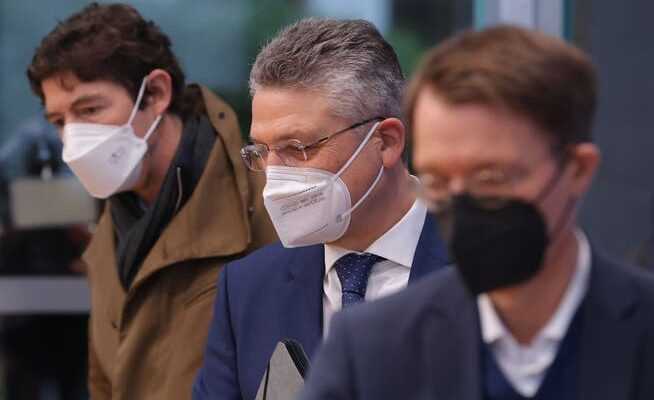The RKI boss Lothar Wieler and the Federal Minister of Health see no reason for easing. The virologist Christian Drosten criticizes the reporting of some media about the pandemic.
Christian Drosten (left), Lothar Wieler and Karl Lauterbach at the federal press conference.
When Federal Health Minister Karl Lauterbach, RKI boss Lothar Wieler and virologist Christian Drosten provided information on the current corona situation at the federal press conference on Friday, it hardly looked like the pandemic situation would ease: With over 90,000 new infections per day, which were reported tomorrow, Germany has reached a new high.
The omicron variant is becoming more and more popular here, and according to Wieler, it now accounts for seventy percent of infections. At the same time, the trend is confirmed that the course of an infection with omicron is relatively mild, especially for vaccinated people.
A difficult double message, said Drosten, because one cannot yet give the all-clear. Wieler explained: “Due to the mass of infections, we unfortunately have to be prepared for the fact that the number of hospitalizations and deaths will increase again.” And so, with the help of tightened measures such as the 2-G-plus rule in gastronomy, the expected “wall” of infection numbers, which Lauterbach spoke of, should at least become a “hill”.
Difficult communication
The Minister of Health warned against accepting an infection in Germany: “The number of victims that we would then have to complain about is certainly too high.” This also does not lead to protection against other variants.
Drosten confessed that it was currently a “very difficult time to communicate”. The ongoing vaccination gap in Germany is a bad prerequisite for containing the pandemic. At the same time, it will not be possible to vaccinate the entire population again and again in the long term. The only question is whether you can already rely on it in Germany. Drosten currently sees the vaccination gap as the biggest obstacle to being able to let the virus run.
Communication is also made more difficult by the fact that there are relatively many infections among vaccinated people. In public, this is misrepresented, partly on purpose, partly out of ignorance, as if it were pointless to get vaccinated. The virologist made it clear that the vaccination slows down the virus and protects it from severe courses. It is ignorant to ignore that.
Discussion about compulsory vaccination
Drosten also made the media responsible: they could help motivate vaccinations. For a long time, some media had propagated that the pandemic was harmless and that the political measures were exaggerated. This has contributed to bringing people into a conflict of understanding. “I think it would be good if the media would help to provide correct information again at this point,” said the virologist.
Although Lauterbach personally, i.e. not in his office as Federal Minister of Health, as he emphasized, spoke out in favor of compulsory vaccination “without ifs and buts”, he criticized it as inappropriate to belittle those who were unwilling to be vaccinated and to speak badly about them. From the triangle of vaccination – “necessary, suitable, moderate” – nevertheless the need to act arises.
However, the federal government is still dependent on measures beyond the obligation to vaccinate. Despite media reports to the contrary, Lauterbach currently sees no lack of test capacities. In order to ensure the ability of the medical staff to work, he had prioritized the PCR tests in this area.
New quarantine rules
On Friday, the Federal Council also approved the new regulation of the shortened quarantine periods decided by the federal and state governments. According to this, infected people and their contacts can be released from isolation or quarantine after seven days if they can show a negative PCR or rapid test. Nurses and medical workers who have become infected can only end the isolation after seven days with a PCR test if they have been symptom-free for 48 hours beforehand.
For children in day-care centers and students, exceptions to the quarantine rule are possible if additional protective measures are taken. Excluded from the quarantine are contact persons who have received a booster vaccination or have been “freshly” vaccinated twice or have recovered, i.e. the date of their illness or vaccination was less than three months ago.
